I've been back in the States for five days. And it almost feels like I've never been gone. Boston is just the same, although the trees have leaves now and the lilacs are blooming and it's been raining everyday since I returned. The top three things I've noticed most about being back:
1. Americans love their cars. I was aching to drive my car again when I got back but have been struck by how little I walk around, now that I have wheels. Seems a bit of a shame and I've decided to walk more and take the T more often.
2. Americans are not healthy. I'm currently in Buffalo, NY, for my little sister's college graduation and have noticed more than anything else, the large numbers of large people here. I just spent a month in a country where the people are too poor to be fat, so the sudden appearance of obese individuals around me is rather stunning. And kinda gross, not gonna lie.
3. I only spoke English maybe 10% (or less) of the time I was in Bolivia. Since I returned, I haven't spoken a lick of Spanish, until today, but that was because I received a phone call from Bolivia. I better figure out a way to speak the language while in Boston.
Been thinking about how to recap the whole month and will have pictures up soon. I'm already missing the boys and my work down there, so composing the summary will be a nice way to revisit them ...
Saturday, May 13, 2006
Sunday, May 07, 2006
Conquering the World's Most Dangerous Road (and a spider)
Forget the stunning views. Forget the World's Most Dangerous Road (WMDR). Forget driving along the WMDR in a white blanket of fog with a visibility of 5 feet. What I will remember from my trip to Coroico is killing the world's biggest spider -- in my bedroom.
I had just wrapped up a lovely conversation with a young French activist named Gregory, after a lovely souffle dinner and a chocolate and banana crepe for dessert, and retired to my room, settling down as comfortably as possible on the flattened "mattress" pad that provided only the slightest bit of cushion. Suddenly, I saw an ugly brown, 4 inch long monster with eight legs creeping up the opposite wall -- you know, the kind that doesn't spin a web to catch food; it hunts for food.
Naturally, I did what anyone else would do -- I screamed and threw on my shoes to run for help. Trust me, had you seen the whopper, this would have been your first instinct too. But then I thought the thing might crawl into my bag, so I shoved everything into my bag, zipped it, and then started to run for help. But the freakin' creature kept moving! Gripped with a sickening fear, I resigned myself to doing the deed. I mean, what if it disappeared under my pillow just as I found someone else to kill it and we couldn't find it and I'd have to die a slow, painful, spider-induced death in my sleep? That just wouldn't do. So, I tore off my boot and cautiously approached the intruder, all the while telling myself that I was a lot bigger than it. I think it understood what I was saying because the beast took off like a rocket. After a short chase, the ghastly brute tried to sneak behind a thatched wall hanging and I mercilessly smashed it through the decor -- once, twice, six times just to be on the safe side. Thus ended the Hunt for the Great Arachnid. It then took about 20 minutes and 736 glances around the room for my heart to stop racing. I hate spiders.
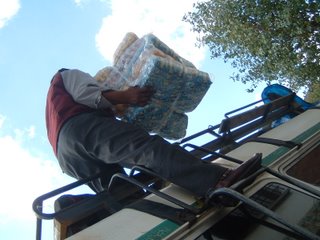 So right. Back to the World's Most Dangerous Road. According to the Inter-American Development Bank, an average of 26 vehicles disappear over the edge. That's about one vehicle every 2 weeks. However, La Paz locals assured me that it was fine, as long as I don't travel at night. So, I merrily booked a seat on the 3pm minibus (which turned out to be a bigger, scarier microbus). As I watched the driver load up the cargo on top of the bus, a 70-something drunk Bolivian man named Miguel tried to befriend me and I quickly moved away. What is it with me and 70 year old Bolivian men?
So right. Back to the World's Most Dangerous Road. According to the Inter-American Development Bank, an average of 26 vehicles disappear over the edge. That's about one vehicle every 2 weeks. However, La Paz locals assured me that it was fine, as long as I don't travel at night. So, I merrily booked a seat on the 3pm minibus (which turned out to be a bigger, scarier microbus). As I watched the driver load up the cargo on top of the bus, a 70-something drunk Bolivian man named Miguel tried to befriend me and I quickly moved away. What is it with me and 70 year old Bolivian men?
We finally boarded around 3:10 pm and guess who was sitting next to me? For the next three hours, Miguel imbibed what smelled like rubbing alcohol, blabbed about his 10 wives, sang love songs, and invited me to his house 18 times. Here are a few of the English equivalents of my side of the conversation: "Yeah." "Whatever." "Why do you think I'm going to do that?" "Who talks like this?" "Why are you touching my arm?" "I'm not sad, you just talk too much. Go away." I became rather rude by the end of the 3 hours.
And I learned that the only thing scarier than driving down the WMDR at night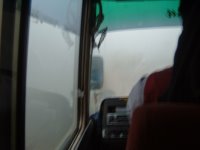 is driving in a fog (and co-habitating with giant arachnids). That's the driver you see over on the right. Notice how you can't really see anything out the window. Eventually, after 2 excruciating hours of blindly winding down a narrow, unpaved mountain road, the fog partially lifted and I caught a glimpse of purple mountains in the distance and big, green, leafy vegetation everywhere. Unfortunately, the view lasted about 20 minutes and it was nighttime. When I finally fell asleep around 2am (with the light on, hoping it would prevent other vermin of the night from emerging), I comforted myself with thoughts of the breathtaking view in the morning light.
is driving in a fog (and co-habitating with giant arachnids). That's the driver you see over on the right. Notice how you can't really see anything out the window. Eventually, after 2 excruciating hours of blindly winding down a narrow, unpaved mountain road, the fog partially lifted and I caught a glimpse of purple mountains in the distance and big, green, leafy vegetation everywhere. Unfortunately, the view lasted about 20 minutes and it was nighttime. When I finally fell asleep around 2am (with the light on, hoping it would prevent other vermin of the night from emerging), I comforted myself with thoughts of the breathtaking view in the morning light.
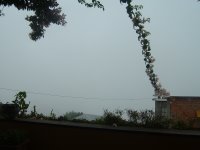 After a restless sleep filled with coughs and sneezes (I've got a cold), I woke up in a fog. Literally. No view. Nothing. Just a lot of thick white fog that nestled itself into every possible crevice of the landscape and suffocated it. I walked to the center of town, keely aware of how out of place I looked into this itty bitty pueblo and chose a German spot for breakfast. Facing the white sheet that had been pulled over the land, I enjoyed the first decent cup of coffee I've had in a month, and chatted with a couple from Denmark. But as a bizarre mix of Bob Marley, opera, Eric Clapton, bad 80s electronica and samba tunes swung through the air, shy Coroico slowly parted her cottony curtain to reveal a lush, emerald green vista. I oohed and aahed diligently, snapped photos, and still came to the conclusion that I wou
After a restless sleep filled with coughs and sneezes (I've got a cold), I woke up in a fog. Literally. No view. Nothing. Just a lot of thick white fog that nestled itself into every possible crevice of the landscape and suffocated it. I walked to the center of town, keely aware of how out of place I looked into this itty bitty pueblo and chose a German spot for breakfast. Facing the white sheet that had been pulled over the land, I enjoyed the first decent cup of coffee I've had in a month, and chatted with a couple from Denmark. But as a bizarre mix of Bob Marley, opera, Eric Clapton, bad 80s electronica and samba tunes swung through the air, shy Coroico slowly parted her cottony curtain to reveal a lush, emerald green vista. I oohed and aahed diligently, snapped photos, and still came to the conclusion that I wou ld rather sleep in the spider-free comfort of Zona Sur in La Paz. I had just enough time to change my bus seat, walk around the center plaza, and chill out on the hostel's mountainside deck. Interestingly enough, I ran into yet another 70-something Bolivian man, who struck up a conversation with me during the uphill trek back to the hostel -- at least this one was nice. He'd worked on a merchant ship that brought goods back and forth from China, Japan, Hong Kong and Taiwan.
ld rather sleep in the spider-free comfort of Zona Sur in La Paz. I had just enough time to change my bus seat, walk around the center plaza, and chill out on the hostel's mountainside deck. Interestingly enough, I ran into yet another 70-something Bolivian man, who struck up a conversation with me during the uphill trek back to the hostel -- at least this one was nice. He'd worked on a merchant ship that brought goods back and forth from China, Japan, Hong Kong and Taiwan.
The ride back to La Paz was wonderfully uneventful, although I bet the other passengers were quietly laughing at the Asian tourist who kept opening the window to take pictures. I've posted below some of the better pictures of Coroico and the ride back. As picturesque as it all is, I was glad to finally make it back to the place I've called home for the past month. Plus, cutting the Coroico trip short meant that I would have one more opportunity to see the boys I had to say goodbye to on Friday. More on that tearful goodbye later. I return to the States tomorrow, hardly able to believe that I've been in Bolivia for a month.
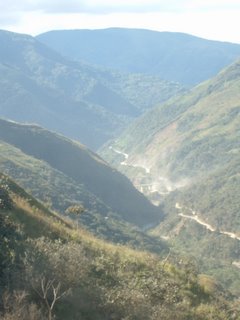
I had just wrapped up a lovely conversation with a young French activist named Gregory, after a lovely souffle dinner and a chocolate and banana crepe for dessert, and retired to my room, settling down as comfortably as possible on the flattened "mattress" pad that provided only the slightest bit of cushion. Suddenly, I saw an ugly brown, 4 inch long monster with eight legs creeping up the opposite wall -- you know, the kind that doesn't spin a web to catch food; it hunts for food.
Naturally, I did what anyone else would do -- I screamed and threw on my shoes to run for help. Trust me, had you seen the whopper, this would have been your first instinct too. But then I thought the thing might crawl into my bag, so I shoved everything into my bag, zipped it, and then started to run for help. But the freakin' creature kept moving! Gripped with a sickening fear, I resigned myself to doing the deed. I mean, what if it disappeared under my pillow just as I found someone else to kill it and we couldn't find it and I'd have to die a slow, painful, spider-induced death in my sleep? That just wouldn't do. So, I tore off my boot and cautiously approached the intruder, all the while telling myself that I was a lot bigger than it. I think it understood what I was saying because the beast took off like a rocket. After a short chase, the ghastly brute tried to sneak behind a thatched wall hanging and I mercilessly smashed it through the decor -- once, twice, six times just to be on the safe side. Thus ended the Hunt for the Great Arachnid. It then took about 20 minutes and 736 glances around the room for my heart to stop racing. I hate spiders.
 So right. Back to the World's Most Dangerous Road. According to the Inter-American Development Bank, an average of 26 vehicles disappear over the edge. That's about one vehicle every 2 weeks. However, La Paz locals assured me that it was fine, as long as I don't travel at night. So, I merrily booked a seat on the 3pm minibus (which turned out to be a bigger, scarier microbus). As I watched the driver load up the cargo on top of the bus, a 70-something drunk Bolivian man named Miguel tried to befriend me and I quickly moved away. What is it with me and 70 year old Bolivian men?
So right. Back to the World's Most Dangerous Road. According to the Inter-American Development Bank, an average of 26 vehicles disappear over the edge. That's about one vehicle every 2 weeks. However, La Paz locals assured me that it was fine, as long as I don't travel at night. So, I merrily booked a seat on the 3pm minibus (which turned out to be a bigger, scarier microbus). As I watched the driver load up the cargo on top of the bus, a 70-something drunk Bolivian man named Miguel tried to befriend me and I quickly moved away. What is it with me and 70 year old Bolivian men?We finally boarded around 3:10 pm and guess who was sitting next to me? For the next three hours, Miguel imbibed what smelled like rubbing alcohol, blabbed about his 10 wives, sang love songs, and invited me to his house 18 times. Here are a few of the English equivalents of my side of the conversation: "Yeah." "Whatever." "Why do you think I'm going to do that?" "Who talks like this?" "Why are you touching my arm?" "I'm not sad, you just talk too much. Go away." I became rather rude by the end of the 3 hours.
And I learned that the only thing scarier than driving down the WMDR at night
 is driving in a fog (and co-habitating with giant arachnids). That's the driver you see over on the right. Notice how you can't really see anything out the window. Eventually, after 2 excruciating hours of blindly winding down a narrow, unpaved mountain road, the fog partially lifted and I caught a glimpse of purple mountains in the distance and big, green, leafy vegetation everywhere. Unfortunately, the view lasted about 20 minutes and it was nighttime. When I finally fell asleep around 2am (with the light on, hoping it would prevent other vermin of the night from emerging), I comforted myself with thoughts of the breathtaking view in the morning light.
is driving in a fog (and co-habitating with giant arachnids). That's the driver you see over on the right. Notice how you can't really see anything out the window. Eventually, after 2 excruciating hours of blindly winding down a narrow, unpaved mountain road, the fog partially lifted and I caught a glimpse of purple mountains in the distance and big, green, leafy vegetation everywhere. Unfortunately, the view lasted about 20 minutes and it was nighttime. When I finally fell asleep around 2am (with the light on, hoping it would prevent other vermin of the night from emerging), I comforted myself with thoughts of the breathtaking view in the morning light. After a restless sleep filled with coughs and sneezes (I've got a cold), I woke up in a fog. Literally. No view. Nothing. Just a lot of thick white fog that nestled itself into every possible crevice of the landscape and suffocated it. I walked to the center of town, keely aware of how out of place I looked into this itty bitty pueblo and chose a German spot for breakfast. Facing the white sheet that had been pulled over the land, I enjoyed the first decent cup of coffee I've had in a month, and chatted with a couple from Denmark. But as a bizarre mix of Bob Marley, opera, Eric Clapton, bad 80s electronica and samba tunes swung through the air, shy Coroico slowly parted her cottony curtain to reveal a lush, emerald green vista. I oohed and aahed diligently, snapped photos, and still came to the conclusion that I wou
After a restless sleep filled with coughs and sneezes (I've got a cold), I woke up in a fog. Literally. No view. Nothing. Just a lot of thick white fog that nestled itself into every possible crevice of the landscape and suffocated it. I walked to the center of town, keely aware of how out of place I looked into this itty bitty pueblo and chose a German spot for breakfast. Facing the white sheet that had been pulled over the land, I enjoyed the first decent cup of coffee I've had in a month, and chatted with a couple from Denmark. But as a bizarre mix of Bob Marley, opera, Eric Clapton, bad 80s electronica and samba tunes swung through the air, shy Coroico slowly parted her cottony curtain to reveal a lush, emerald green vista. I oohed and aahed diligently, snapped photos, and still came to the conclusion that I wou ld rather sleep in the spider-free comfort of Zona Sur in La Paz. I had just enough time to change my bus seat, walk around the center plaza, and chill out on the hostel's mountainside deck. Interestingly enough, I ran into yet another 70-something Bolivian man, who struck up a conversation with me during the uphill trek back to the hostel -- at least this one was nice. He'd worked on a merchant ship that brought goods back and forth from China, Japan, Hong Kong and Taiwan.
ld rather sleep in the spider-free comfort of Zona Sur in La Paz. I had just enough time to change my bus seat, walk around the center plaza, and chill out on the hostel's mountainside deck. Interestingly enough, I ran into yet another 70-something Bolivian man, who struck up a conversation with me during the uphill trek back to the hostel -- at least this one was nice. He'd worked on a merchant ship that brought goods back and forth from China, Japan, Hong Kong and Taiwan.The ride back to La Paz was wonderfully uneventful, although I bet the other passengers were quietly laughing at the Asian tourist who kept opening the window to take pictures. I've posted below some of the better pictures of Coroico and the ride back. As picturesque as it all is, I was glad to finally make it back to the place I've called home for the past month. Plus, cutting the Coroico trip short meant that I would have one more opportunity to see the boys I had to say goodbye to on Friday. More on that tearful goodbye later. I return to the States tomorrow, hardly able to believe that I've been in Bolivia for a month.


Wednesday, May 03, 2006
Feed the birds
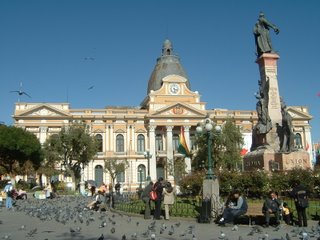 I finally made it to La Paz's most picturesque and most important plaza yesterday -- The Plaza Murillo, where last year, 80,000 protestors surrounded the presidential palace (left) to demand the nationalization of the gas industry and where, just two days ago, President Evo Morales announced that the country's gas reserves would be nationalzed. Bolivia has the second largest gas reserves in South America and, thus far, has reaped very little reward from it. In theory, this new development should increase energy-related revenues to $780 million, almost six times what they received in 2002. Of course, you have to hope that, in a departure from most of Bolivia's previous leaders, Morales won't use the new income to line his own pockets. Hopefully his two best friends, Hugo Chavez and Fidel Castro, won't negatively influence him. (Of all the world leaders to call buddies .... )
I finally made it to La Paz's most picturesque and most important plaza yesterday -- The Plaza Murillo, where last year, 80,000 protestors surrounded the presidential palace (left) to demand the nationalization of the gas industry and where, just two days ago, President Evo Morales announced that the country's gas reserves would be nationalzed. Bolivia has the second largest gas reserves in South America and, thus far, has reaped very little reward from it. In theory, this new development should increase energy-related revenues to $780 million, almost six times what they received in 2002. Of course, you have to hope that, in a departure from most of Bolivia's previous leaders, Morales won't use the new income to line his own pockets. Hopefully his two best friends, Hugo Chavez and Fidel Castro, won't negatively influence him. (Of all the world leaders to call buddies .... )Plaza Murillo is kind of the Trafalgar Square of La Paz. Pigeons are everywhere, people are lounging about on long lunch breaks, vendors sell bird food for tuppance a bag ... or was that in
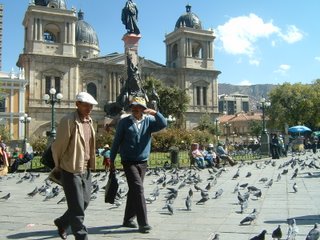 Mary Poppins? Anyway, I hung around for an hour or so, played with a cute-as-a-button, random 3 year old girl, watched other children torment and chase pigeons, which didn't bother me since they are nasty, vile, dirty things. The birds, not the children. That's the 1835 cathedral on the right.
Mary Poppins? Anyway, I hung around for an hour or so, played with a cute-as-a-button, random 3 year old girl, watched other children torment and chase pigeons, which didn't bother me since they are nasty, vile, dirty things. The birds, not the children. That's the 1835 cathedral on the right.With more time to spare, I wandered down toward the San Francisco Plaza, where all kinds of handicrafts, trinkets, and other goods are on sale. Accidentally stumbled into the flower market (literally, fell into a stall. Luckily, the lady was very nice to me) and then put my negotiation skills to the test. My father would have been proud -- although I had to concede $30Bs (less than $4US), I put the vendor under enough pressure that she had to call her boss to make sure the deal was okay. I love when that happens!
Tuesday, May 02, 2006
The free radical
I've been reading The Beatitudes (Book of Matthew, Chapter 5) this week and have been pondering the crazy, radical teaching of Jesus. I mean, this guy talks about lifting up and rewarding the meek, the merciful, the pure in heart, the gentle, the peaceful -- it makes me think about the people, celebrities and heroes we look to as role models, and wow, so few of them exhibit those characteristics. And I dare you to name a world leader who fits this bill!
In my readings, I also came across a great summary from author John Stott, who said "In brief, Jesus congratulates those whom the world most pities, and calls the world's rejects 'blessed.'"
What comes to mind immediately are all the children that I've been working with during the past month: the street children who are rejected by all the other shelters and turn to drugs and prostitution; the boys who shine shoes to earn a few cents but wear scarves covering their entire faces to avoid the stigma of being on the street. The ones who drool and can't form complete sentences because they are so high on thinner. The poor family who can't afford hot water, the mother who sells handicrafts on the sidewalk and has no choice but to allow her three-year-old to play in the street. This would have been the crowd that Jesus would have hung out with, the ones he would call 'blessed' or 'happy'. Way to be.
I'll tell you who I think fits the bill in those first 10 verses of Matthew 5. His name is Israel and he lives in the Renacer Home. At 13 years old, Israel is the sweetest boy I think I've ever met (besides my lovely boyfriend who will pick me up from the airport on Monday, right, babe?) Israel is the quiet kid in the back of the classroom, who doesn't need to bounce in his seat to show the teacher he knows the right answer. He doesn't have his own desk (probably because the louder and more showy kids grabbed them first) and instead has to share a wooden table with another boy. Like me, Israel absolutely loves to read; he's also an artist, loves to take photos and he shares all his stuff with the rest of the boys. He's the one who cares for the adorable kitten, Estuart, and tries to avoid unhealthy conflict whenever possible. But he's not a pushover -- he's athletic, plays football, does your normal 'boy' stuff too. I know I keep saying this, but I can't believe he used to be a streetkid. I just hope he doesn't lose these wonderful traits, that he doesn't became jaded by life's twists and turns, that he keeps hold of his imagination and creativity. This small, quiet 13 year old boy is truly the salt of the earth.
In my readings, I also came across a great summary from author John Stott, who said "In brief, Jesus congratulates those whom the world most pities, and calls the world's rejects 'blessed.'"
What comes to mind immediately are all the children that I've been working with during the past month: the street children who are rejected by all the other shelters and turn to drugs and prostitution; the boys who shine shoes to earn a few cents but wear scarves covering their entire faces to avoid the stigma of being on the street. The ones who drool and can't form complete sentences because they are so high on thinner. The poor family who can't afford hot water, the mother who sells handicrafts on the sidewalk and has no choice but to allow her three-year-old to play in the street. This would have been the crowd that Jesus would have hung out with, the ones he would call 'blessed' or 'happy'. Way to be.
I'll tell you who I think fits the bill in those first 10 verses of Matthew 5. His name is Israel and he lives in the Renacer Home. At 13 years old, Israel is the sweetest boy I think I've ever met (besides my lovely boyfriend who will pick me up from the airport on Monday, right, babe?) Israel is the quiet kid in the back of the classroom, who doesn't need to bounce in his seat to show the teacher he knows the right answer. He doesn't have his own desk (probably because the louder and more showy kids grabbed them first) and instead has to share a wooden table with another boy. Like me, Israel absolutely loves to read; he's also an artist, loves to take photos and he shares all his stuff with the rest of the boys. He's the one who cares for the adorable kitten, Estuart, and tries to avoid unhealthy conflict whenever possible. But he's not a pushover -- he's athletic, plays football, does your normal 'boy' stuff too. I know I keep saying this, but I can't believe he used to be a streetkid. I just hope he doesn't lose these wonderful traits, that he doesn't became jaded by life's twists and turns, that he keeps hold of his imagination and creativity. This small, quiet 13 year old boy is truly the salt of the earth.
How would you like your corn?
A few Cochabamba statistics for you:
1. In this region of Bolivia, there are supposedly nearly 100 types of corn and 200 types of potatoes. I haven't had a chance to really research it, but it sure seemed that way. I, personally, enjoyed various types of corn four different ways -- off the cob, api (a sweet drink), tojori (another drink), and chicha (an alcholic brew made from corn and tastes kind of like Mike's Hard Lemonade). It was Orieta's 76-year-old aunt who took me out for a drink during my visit.

2. Cochabamba boasts the biggest open air market in South America. Called La Cancha, it is the most overwhelming, dizzying, exhausting market I've ever been to. Imagine the craziest outdoor market you've experienced and multiply it by 200. Now you're close. Filled with fake Gap, Ralph Lauren, Nike, Puma, you name the brand, La Cancha goes on for blocks and blocks -- even the markets in Bangkok couldn't hold a candle.
3. They also boast the highest statue of Christ. The more famous statue in Rio de Janeiro rises to 33 meters, one meter for each year of Jesus' life. The Cochabamba statue is 33 meters and a few centimeters, justified by the Cochabambinos because Christ lived "33 years and a little bit." I climbed to the top of the statue and peered out the small holes, which provided the only light inside. My quads were so sore the next day and I'm blaming the altitude. And if you have a problem with that, you can race against my super-duper new lung capacity when I get back to the States.
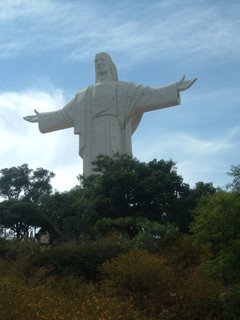
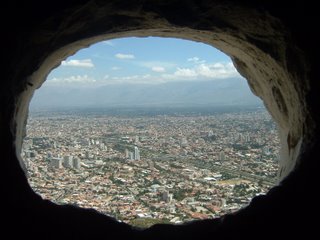
4. Never, ever take the last bus out of Cochabamba. Especially not on the eve of The Day of the Worker (May 1). For more details, read the next entry.
1. In this region of Bolivia, there are supposedly nearly 100 types of corn and 200 types of potatoes. I haven't had a chance to really research it, but it sure seemed that way. I, personally, enjoyed various types of corn four different ways -- off the cob, api (a sweet drink), tojori (another drink), and chicha (an alcholic brew made from corn and tastes kind of like Mike's Hard Lemonade). It was Orieta's 76-year-old aunt who took me out for a drink during my visit.

2. Cochabamba boasts the biggest open air market in South America. Called La Cancha, it is the most overwhelming, dizzying, exhausting market I've ever been to. Imagine the craziest outdoor market you've experienced and multiply it by 200. Now you're close. Filled with fake Gap, Ralph Lauren, Nike, Puma, you name the brand, La Cancha goes on for blocks and blocks -- even the markets in Bangkok couldn't hold a candle.
3. They also boast the highest statue of Christ. The more famous statue in Rio de Janeiro rises to 33 meters, one meter for each year of Jesus' life. The Cochabamba statue is 33 meters and a few centimeters, justified by the Cochabambinos because Christ lived "33 years and a little bit." I climbed to the top of the statue and peered out the small holes, which provided the only light inside. My quads were so sore the next day and I'm blaming the altitude. And if you have a problem with that, you can race against my super-duper new lung capacity when I get back to the States.


4. Never, ever take the last bus out of Cochabamba. Especially not on the eve of The Day of the Worker (May 1). For more details, read the next entry.
Monday, May 01, 2006
Beware of the last bus
While the weekend in Cochabamba was highly enjoyable and quite interesting, the highlight of the trip was actually the bus ride, both to and from Bolivia’s third largest city. I’ll take a few minutes later to write about the stuff I actually did and the food I ate, but this session is devoted entirely to the transit turmoil.
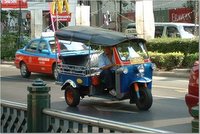 The way to CBA is your typical, detestable 7-hour bus ride: dirty, creaky, infested with crying babies and body odor, packed to the hilt (including a filthy, white dog named Violetta). And a kung fu movie from Thailand, which, no joke, featured the best and only tuk-tuk chase scene I’ve ever watched (see left for a tuk-tuk) . At first I thought the movie was just to help pass the remaining four hours, but I soon realized it’s true purpose is to distract you from the treacherous, narrow, winding road through the mountains that your big, double decker bus is trying to navigate in pitch black darkness.
The way to CBA is your typical, detestable 7-hour bus ride: dirty, creaky, infested with crying babies and body odor, packed to the hilt (including a filthy, white dog named Violetta). And a kung fu movie from Thailand, which, no joke, featured the best and only tuk-tuk chase scene I’ve ever watched (see left for a tuk-tuk) . At first I thought the movie was just to help pass the remaining four hours, but I soon realized it’s true purpose is to distract you from the treacherous, narrow, winding road through the mountains that your big, double decker bus is trying to navigate in pitch black darkness.
But, the experience was mildly worth it – everything from the La Paz bus terminal where bus companies hire people to yell their destinations at you, to the random $2Bs extra fee you pay to get to where the buses depart, to the vendors who hop on and off the bus during your journey to sell drinks, snacks and ice cream. It’s almost like being in a moving baseball stadium. Almost.
After the kung fu movie ended, I tried to look out the front to see the road, but the oncoming trailer trucks, the freaky cliff drop to the left, and the way the bus clunked on the severe curves (the same way my old Nissan did when the mechanics told me my axle was about to snap) all made me a little nervous, so I opted to watch the sky. Good move – I quickly became enamored with the all the stars, and it was as though I’d never really seen the night sky before; the way it’s deepness opens up over the mountains; the Southern Cross; how stars sprinkle light upon the landscape … Unfortunately, I think the magic of the moment was lost on my travel companion, Orieta, who was understandably suffering from motion sickness. I, however, dozed off with the pinpricked image of the sky in my head....
And then there was the return trip.
We booked ourselves on the last “red eye” bus out of CBA at 9:30 p.m. (This is a highly important piece of information and you should remember to never, ever, ever take the last bus. Ever. )
The trip started out deceptively normal. Crowded terminal, people yelling, full bus, crying babies, smelly bodies, dirty dogs. But after we left the terminal, our bus paused just before turning onto the street and a few more people got on. Except that there weren’t any seats for them and they sat in the aisle. Now, my first reaction was, oooo that SUCKS to sit there for the next 7 hours. But the other people around me were annoyed and they started to call out the window, “We’re full, you can’t pack people in like this. Let’s get going!”
So, away we went … until the bus paused again and then again in other parts of town, where there were (I kid you not) at least 50 more people waiting, all with gigantic and heavy bags, suitcases and packs. Most of them were poor, indigenous background and in “chola” dress, with their babies strapped to their backs in colorful blankets. And the fun began. The people who paid full price were outraged – and they really started to yell. “It’s not safe! You can’t put more people on this bus! Get moving! Go!” They were yelling out the windows, they were getting up and yelling down to the door, they were riling each other up. Whoa. Being a little naïve, I started thinking, oh what’s the big deal? These are poor people who need to get back home and this is the last bus (I told you that was important info). And then I started thinking about an overcrowded, overweight, overstuffed, double decker bus rushing around the violent curves of the mountain road. And I decided that I would prefer not to die on a bus in a mountain crash in Bolivia.
and then again in other parts of town, where there were (I kid you not) at least 50 more people waiting, all with gigantic and heavy bags, suitcases and packs. Most of them were poor, indigenous background and in “chola” dress, with their babies strapped to their backs in colorful blankets. And the fun began. The people who paid full price were outraged – and they really started to yell. “It’s not safe! You can’t put more people on this bus! Get moving! Go!” They were yelling out the windows, they were getting up and yelling down to the door, they were riling each other up. Whoa. Being a little naïve, I started thinking, oh what’s the big deal? These are poor people who need to get back home and this is the last bus (I told you that was important info). And then I started thinking about an overcrowded, overweight, overstuffed, double decker bus rushing around the violent curves of the mountain road. And I decided that I would prefer not to die on a bus in a mountain crash in Bolivia.
Orieta went down to see what was going on and came back to tell me that the driver was drunk and was actually packing people and their stuff into the baggage hold under the bus! And that three months earlier, a bus had gone off the road because it was overweight for the same reasons and more than 20 people died. Fabulous. Now, the aisles were more full, people were calling the police, Orieta told me to start taking photos out the window to document, and everyone decided that when the bus arrived at the toll booth, we’d yell for the police and get the driver to stop.
Which is what we did. So the bus pulled over, we got out and found ourselves faced not only with the driver and the solitary police officer, but with another 20 or people who wanted to get on our bus. I started snapping photos of the bus license plate and the bus, which angered the Indians because they thought I was taking pictures of them. Luckily, they were quickly distracted by all the bellowing around the police officer.
I’ve never experienced anything quite like it – the yelling started out about the safety issue. Then it turned low-blow, an outlet for pent-up anger and frustration, just plain ugly. One woman shrieked that this was her country and even though she was poor, she had a right to be on the bus – which didn’t go over well, since nearly everyone else on the bus was also Bolivian-born. Others were howling for respect, others for fairness. In this one evening, I felt the fuel that has caused Bolivia to experience more coups than any other South American country, that causes the thick line dividing rich from poor to burst into flames. No wonder, then, that a poverty-born, coca leaf grower, Aymara man named Evo Morales was elected president of the country.
Back at the toll booth, the vein-popping, face-reddening screaming continued to escalate and then a man started to yell out “Let’s blockade the bus! We can block the bus right here, form a line of people to blockade! Blockade! Blockade!”
Oh, please, no.
The next thing I knew, we were being herded back on the bus, still with the yelling all around. I heard some woman scream out about “La china” (me) taking photos and some other woman came over to kick me in the back of the legs. Which was rather ineffective and I just looked right at her quizzically. She didn’t have anything to say, so I just gave her a disgusted look and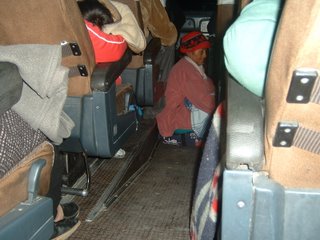 boarded. The police officer came through to make sure that everyone actually had a seat (although he made a few exceptions). And when he left, the second, sober driver snuck a few people into the bottom of the bus. I rationalized with the butterflies in my stomach that at least the aisles weren’t completely packed.
boarded. The police officer came through to make sure that everyone actually had a seat (although he made a few exceptions). And when he left, the second, sober driver snuck a few people into the bottom of the bus. I rationalized with the butterflies in my stomach that at least the aisles weren’t completely packed.
Needless to say, the stars didn’t exactly provide the same relaxation as the first trip. Times like these, I’m so glad that I believe in a God who listens. I was praying like crazy, but figured that the Jesus guy who calmed the wind, rain, and sea could probably get me back to La Paz. I eventually settled into a restless sleep that was interrupted by the periodic snoring snorts of the old woman across the aisle, the oncoming trucks that honk at you just to double check that you know they’re coming, and the bumps of the road sections that aren’t paved.
After dumping our stowaways and all their luggage out of the bus a block from the bus terminal, we had finally made it to La Paz and hurried into the first cab available … only to find that our cab driver was more than a little drunk and babbled the whole way about Venezuela, how much he pays for gas, and how he doesn’t fight with his wife. Oddly enough, the ride didn’t seem any less spastic or horrifying than a normal taxi ride with a sober driver in La Paz rush hour. At 5:37 a.m., I finally crumbled into bed, safe and sound.
After that, a ride down the Road of Death next weekend should be a cakewalk.
 The way to CBA is your typical, detestable 7-hour bus ride: dirty, creaky, infested with crying babies and body odor, packed to the hilt (including a filthy, white dog named Violetta). And a kung fu movie from Thailand, which, no joke, featured the best and only tuk-tuk chase scene I’ve ever watched (see left for a tuk-tuk) . At first I thought the movie was just to help pass the remaining four hours, but I soon realized it’s true purpose is to distract you from the treacherous, narrow, winding road through the mountains that your big, double decker bus is trying to navigate in pitch black darkness.
The way to CBA is your typical, detestable 7-hour bus ride: dirty, creaky, infested with crying babies and body odor, packed to the hilt (including a filthy, white dog named Violetta). And a kung fu movie from Thailand, which, no joke, featured the best and only tuk-tuk chase scene I’ve ever watched (see left for a tuk-tuk) . At first I thought the movie was just to help pass the remaining four hours, but I soon realized it’s true purpose is to distract you from the treacherous, narrow, winding road through the mountains that your big, double decker bus is trying to navigate in pitch black darkness.But, the experience was mildly worth it – everything from the La Paz bus terminal where bus companies hire people to yell their destinations at you, to the random $2Bs extra fee you pay to get to where the buses depart, to the vendors who hop on and off the bus during your journey to sell drinks, snacks and ice cream. It’s almost like being in a moving baseball stadium. Almost.
After the kung fu movie ended, I tried to look out the front to see the road, but the oncoming trailer trucks, the freaky cliff drop to the left, and the way the bus clunked on the severe curves (the same way my old Nissan did when the mechanics told me my axle was about to snap) all made me a little nervous, so I opted to watch the sky. Good move – I quickly became enamored with the all the stars, and it was as though I’d never really seen the night sky before; the way it’s deepness opens up over the mountains; the Southern Cross; how stars sprinkle light upon the landscape … Unfortunately, I think the magic of the moment was lost on my travel companion, Orieta, who was understandably suffering from motion sickness. I, however, dozed off with the pinpricked image of the sky in my head....
And then there was the return trip.
We booked ourselves on the last “red eye” bus out of CBA at 9:30 p.m. (This is a highly important piece of information and you should remember to never, ever, ever take the last bus. Ever. )
The trip started out deceptively normal. Crowded terminal, people yelling, full bus, crying babies, smelly bodies, dirty dogs. But after we left the terminal, our bus paused just before turning onto the street and a few more people got on. Except that there weren’t any seats for them and they sat in the aisle. Now, my first reaction was, oooo that SUCKS to sit there for the next 7 hours. But the other people around me were annoyed and they started to call out the window, “We’re full, you can’t pack people in like this. Let’s get going!”
So, away we went … until the bus paused again
 and then again in other parts of town, where there were (I kid you not) at least 50 more people waiting, all with gigantic and heavy bags, suitcases and packs. Most of them were poor, indigenous background and in “chola” dress, with their babies strapped to their backs in colorful blankets. And the fun began. The people who paid full price were outraged – and they really started to yell. “It’s not safe! You can’t put more people on this bus! Get moving! Go!” They were yelling out the windows, they were getting up and yelling down to the door, they were riling each other up. Whoa. Being a little naïve, I started thinking, oh what’s the big deal? These are poor people who need to get back home and this is the last bus (I told you that was important info). And then I started thinking about an overcrowded, overweight, overstuffed, double decker bus rushing around the violent curves of the mountain road. And I decided that I would prefer not to die on a bus in a mountain crash in Bolivia.
and then again in other parts of town, where there were (I kid you not) at least 50 more people waiting, all with gigantic and heavy bags, suitcases and packs. Most of them were poor, indigenous background and in “chola” dress, with their babies strapped to their backs in colorful blankets. And the fun began. The people who paid full price were outraged – and they really started to yell. “It’s not safe! You can’t put more people on this bus! Get moving! Go!” They were yelling out the windows, they were getting up and yelling down to the door, they were riling each other up. Whoa. Being a little naïve, I started thinking, oh what’s the big deal? These are poor people who need to get back home and this is the last bus (I told you that was important info). And then I started thinking about an overcrowded, overweight, overstuffed, double decker bus rushing around the violent curves of the mountain road. And I decided that I would prefer not to die on a bus in a mountain crash in Bolivia.Orieta went down to see what was going on and came back to tell me that the driver was drunk and was actually packing people and their stuff into the baggage hold under the bus! And that three months earlier, a bus had gone off the road because it was overweight for the same reasons and more than 20 people died. Fabulous. Now, the aisles were more full, people were calling the police, Orieta told me to start taking photos out the window to document, and everyone decided that when the bus arrived at the toll booth, we’d yell for the police and get the driver to stop.
Which is what we did. So the bus pulled over, we got out and found ourselves faced not only with the driver and the solitary police officer, but with another 20 or people who wanted to get on our bus. I started snapping photos of the bus license plate and the bus, which angered the Indians because they thought I was taking pictures of them. Luckily, they were quickly distracted by all the bellowing around the police officer.
I’ve never experienced anything quite like it – the yelling started out about the safety issue. Then it turned low-blow, an outlet for pent-up anger and frustration, just plain ugly. One woman shrieked that this was her country and even though she was poor, she had a right to be on the bus – which didn’t go over well, since nearly everyone else on the bus was also Bolivian-born. Others were howling for respect, others for fairness. In this one evening, I felt the fuel that has caused Bolivia to experience more coups than any other South American country, that causes the thick line dividing rich from poor to burst into flames. No wonder, then, that a poverty-born, coca leaf grower, Aymara man named Evo Morales was elected president of the country.
Back at the toll booth, the vein-popping, face-reddening screaming continued to escalate and then a man started to yell out “Let’s blockade the bus! We can block the bus right here, form a line of people to blockade! Blockade! Blockade!”
Oh, please, no.
The next thing I knew, we were being herded back on the bus, still with the yelling all around. I heard some woman scream out about “La china” (me) taking photos and some other woman came over to kick me in the back of the legs. Which was rather ineffective and I just looked right at her quizzically. She didn’t have anything to say, so I just gave her a disgusted look and
 boarded. The police officer came through to make sure that everyone actually had a seat (although he made a few exceptions). And when he left, the second, sober driver snuck a few people into the bottom of the bus. I rationalized with the butterflies in my stomach that at least the aisles weren’t completely packed.
boarded. The police officer came through to make sure that everyone actually had a seat (although he made a few exceptions). And when he left, the second, sober driver snuck a few people into the bottom of the bus. I rationalized with the butterflies in my stomach that at least the aisles weren’t completely packed.Needless to say, the stars didn’t exactly provide the same relaxation as the first trip. Times like these, I’m so glad that I believe in a God who listens. I was praying like crazy, but figured that the Jesus guy who calmed the wind, rain, and sea could probably get me back to La Paz. I eventually settled into a restless sleep that was interrupted by the periodic snoring snorts of the old woman across the aisle, the oncoming trucks that honk at you just to double check that you know they’re coming, and the bumps of the road sections that aren’t paved.
After dumping our stowaways and all their luggage out of the bus a block from the bus terminal, we had finally made it to La Paz and hurried into the first cab available … only to find that our cab driver was more than a little drunk and babbled the whole way about Venezuela, how much he pays for gas, and how he doesn’t fight with his wife. Oddly enough, the ride didn’t seem any less spastic or horrifying than a normal taxi ride with a sober driver in La Paz rush hour. At 5:37 a.m., I finally crumbled into bed, safe and sound.
After that, a ride down the Road of Death next weekend should be a cakewalk.
Subscribe to:
Posts (Atom)
